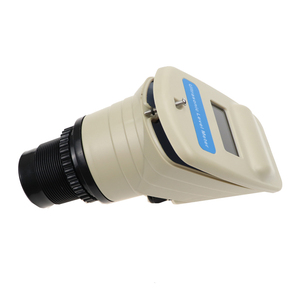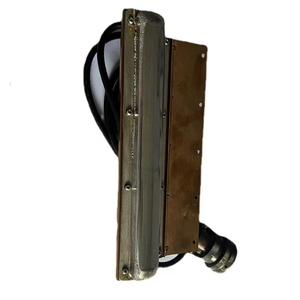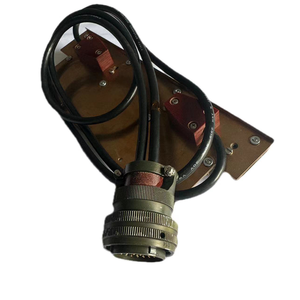
All categories
Featured selections
Trade Assurance
Buyer Central
Help Center
Get the app
Become a supplier

(1777 products available)





































Suppliers create several kinds of high-quality ultrasonic leaks, and each one has been developed for a specific use or industry. In professional settings where much needs to be learned about liquid and gas integrity, on-time detection is crucial.
Portable Ultrasonic Leak Detectors
Portable ultrasonic leak detectors are widely applied because of their sensitivity, focused directions, and accuracy. Portable ultrasonic leak detectors fit into almost any environment and remain particularly beneficial in industrial, commercial, and maintenance applications. Technicians easily find leaks because ultrasonic detectors are lightweight, battery-operated, and simple to maneuver in tight or inaccessible areas. They are frequently used in predictive maintenance programs to help find equipment deterioration before it causes failure. Many ultrasonic portable leak detectors also have the advantage of being able to record audio, enabling further diagnosis and leak source identification in the future.
Fixed Ultrasonic Leak Detectors
Fixed ultrasonic leak detectors are typically installed in plants and industrial sites for continuous monitoring. These detectors, unlike handheld versions, automatically scan for ultrasonic emissions and will sound an alarm or issue a notification when a leak is detected. The most significant advantage of these systems is that they work 24/7, helping to reduce human error and ensuring that no leaks go undetected because they were not noticed by an operator. The big ultrasonic leak detectors are best suited to large-scale industrial operations where continuous leak monitoring is essential for safety and efficiency.
Clamp-on Ultrasonic Leak Detectors
Clamp-on ultrasonic leak detectors provide a non-invasive method for leak detection by focusing on temporarily clamped sensors onto pipes and equipment leak detection wish to be performed on. These detectors can differentiate between the sound of gas leaking through a pipe and the normal ultrasonic emission of the gas or liquid by bouncing an ultrasonic wave off the surface of the pipe.
This makes it easy to detect leaks without cutting into the pipe or disrupting the operation, which provides accurate results. Clamp-on detectors work well in environments where traditional detection methods would be impossible or where shutting down operation.
Ultrasonic Microphone Leak Detectors
Ultrasonic microphone leak detectors use highly sensitive ultrasonic microphones to pick up the sound of gas or liquid escaping from small openings. These detectors convert the detected ultrasonic sound into audible sound, allowing the user to hear the leaks as they walk around the suspect area. Ultrasonic microphone leak detectors work well in pinpointing leaks in high-pressure systems, vacuum systems, and in any situation where small leaks go undetected.
Ultrasonic leak detectors are used across many industries to provide safety and effectiveness in the operation and help with sustainability.
HVAC (Heating, Ventilation, and Air Conditioning)
Ultrasonic HVAC leak detectors help identify refrigerant leaks, which can seriously undercut system efficiency and even pose safety risks. HVAC leak detection tools can identify small refrigerant leaks, cutting excess energy costs, and helping avoid major system breakdowns.
Manufacturing
In the manufacturing industry, ultrasonic leak detectors are used to test product integrity and help identify leaks in finished products like containers, bottles, and other packaging. Detectors identify leaks during quality checks, increasing product safety and reliability.
Petrochemical and Chemical Industries
The petrochemical and chemical industries use ultrasonic leak detectors to monitor the integrity of pipelines and storage tanks containing hazardous materials. Ultrasonic devices can detect minute gas emissions, reducing the possibility of explosions, fires, and toxic exposure. Furthermore, leak detection aids in minimizing product loss and large repair costs.
Pharmaceuticals
Pharmaceutical companies use leak detectors to check the integrity of packaging materials and containers so no contaminants will enter the product. Contaminant entry can affect the medicine's effectiveness and pollute drugs, medical equipment, and other items. Leak detection equipment works to ensure the highest product safety and quality standards.
Aerospace
The aerospace industry uses leak detectors to check the integrity of very complex systems and aircraft components. Ultrasonic detectors work to identify minute leaks in fuel systems, pressurized cabins, and other critical areas. Early leak detection improves safety, reduces the chance of in-flight issues, and eliminates the need for costly repairs.
Energy and Utilities
In the energy and utility sectors, ultrasonic leak detection works to promote the safety of gas distribution systems, steam traps, and other infrastructure. Detectors help minimize leakage associated with safety issues, environmental damage, and economic loss.
Ultrasonic leak detectors are generally characterized by specifications relating to operational performance, detection capacity, and user adaptability.
Frequency Range
Most ultrasonic leak detectors work within the frequency range of 20 kHz to 100 kHz, while some other models can work as high as 200 kHz. This is because the higher the frequency range, the more sensitive the detector is, and this is even more effective at identifying leaks, especially small or in hard-to-reach locations. The frequency range plays a major part in determining the device's ability to detect ultrasonic sound associated with gas or liquid escaping from pinholes, cracks, or leaks.
Sensitivity
The sensitivity of an ultrasonic gas leak detector determines the smallest detectable leak it can identify. Most good-quality detectors have adjustable sensitivity levels that can be fine-tuned depending on the particular application or environmental conditions. This is particularly useful in variable environments where background noise can affect detection capabilities.
Detection Distance
In general, the detection distance of the ultrasonic leak detectors is about 15 to 25 feet, provided that the given line of sight is clear of any obstruction. Some advanced models have increased this to about 30 feet, and other factors affect this on a level basis, including the atmospheric conditions around the area, the background noise, and the type of leak. The size of the leak will significantly determine how far away it can be detected by the equipment.
Power Supply
While many ultrasonic leak detectors are powered by rechargeable lithium-ion batteries, some older models still use regular AA or C batteries. Although corded power supply options are available, these are more prevalent with fixed ultrasonic leak detectors.
Weatherproof Rating
Various types of Ultrasonic Leak Detectors are designed for indoor application only, while some are suitable for outdoor use and weatherproof. Models intended for outdoor use are usually kept in a case that is rated for IP65 or higher, which means they are protected from dust and water ingress. Such weatherproofing is important for applications in outdoor environments.
In selecting ultrasonic leak detectors for clients, one will have to consider several factors since various models and types are available in the market today. Below are some of these factors.
Detector Sensitivity and Accuracy
The level of sensitivity and accuracy will determine the size of the leak the detector can find and how well it will be detected. Fugitive emissions detectors with strong sensitivity are suitable for finding small leaks. Accurate detectors reduce false positives and work great, especially in critical industries where the slightest leak can lead to disaster.
Industry-Specific Needs
When choosing the right leak detectors, one should consider the individual needs of various industries. For example, the aerospace and pharmaceutical industries need detectors with extreme sensitivity and accuracy, while the manufacturing and energy sectors will require equipment that can handle large-scale operations. In other words, the right ultrasonic leak detector for one industrial application will depend on the working environment and the crucial factors of safety and integrity.
Portability vs. Fixed Solutions
The choice between portable and fixed ultrasonic leak detectors should be based on one client's operational requirements. If a client requires continuous monitoring in a stationary environment, then a fixed detector should do the job. If the customer needs flexibility and hands-on leak detection in various locations, a hand-held one would be better. Each type of detector has its advantages, which makes it suitable for different industries and applications.
Detector Durability in Different Conditions
Durability and endurance are important factors to consider when selecting ultrasonic leak detectors for the clients' needs in harsh environments, such as in outdoor or industrial locations where the pollution level is high or where extreme weather conditions detected. Look for leak detectors in the IP65-rated housing, corrosion-resistant materials, and other weatherproof features. The strength of the ultrasonic leak detector casing will ensure that it is operated for many years even in rugged environments.
Ultrasonic leak detectors are primarily designed to detect the sound of gas escaping from leaks by pinpointing the ultrasonic vibrations that fluid often produces while trying to escape through tiny openings, cracks, or holes in surfaces. The equipment is also able to identify liquid leaks by very careful and accurate placement of the transducer and using specific detection techniques, though with more difficulty than gas. While most of them work better with gaseous leaks because gas leakage is generally more than liquid, some models of ultrasonics can perform both types of leakage detection, depending on the industry where they will be put to use.
Users should do normal maintenance on their ultrasonic leak detectors to ensure they work well. Start by always checking and cleaning the transducers after each use since dirt or debris will affect the sensitivity of the equipment. Clients should be advised to store his instrument in a cool, dry place and also check it from time to time to determine if it needs calibration; follow the procedures in the manual concerning calibration, and do it regularly. One should not forget to inspect other components, like the battery or the housing, and to replace or repair them as needed. Proper handling and maintenance of these leak detectors will ensure they will be effective for a long time.
When not in use, store ultrasonic leak detectors in a clean, dry area, free from extreme temperatures, moisture, and dust. Many of these detectors, especially portable ones, would come with a protective carrying case or a hard-wearing padded case to protect them from physical shocks, scratches, and atmospheric conditions that may affect their functionality. Fixed detectors should be mounted in a way that their sensing elements will not be damaged by any obstruction, and always be covered. Detectors shouldn't be kept in areas where chemicals or volatile substances will affect their electronic components or sensitive sensors.
Aside from regular cleaning, storage, and maintenance, users also advise them to do periodic calibrations of their equipment based on how often the equipment is being used and the type of environment in which it is used. Because of its sensitivity and accuracy, calibration helps adjust the detector to the proper sensitivity level to satisfy the manufacturer's stated optimum performance. In clients with demanding operations, or where environmental conditions are prone to change, or where the integrity of the result is critical, the users should more frequently perform calibration.